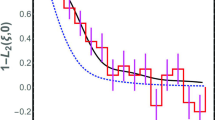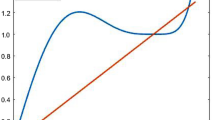Abstract
Methods for the ab initio structure analysis of periodic approximant phases from single- crystal X-ray diffraction data are presented. These methods are particularly suited to complex approximant structures with large unit cells and strong pseudosymmetry (where routine X-ray structure solution tools fail) and are based on the “brute-force” deconvolution of the experimentally measured autocorrelation function. This function is obtained directly by a simple Fourier transform of the measured X-ray diffraction intensities. Sub-optimal diffraction data from twinned, nanodomain and polycrystalline specimens can be processed despite the inevitable lack of information due to reflection overlap and limited resolution. The deconvolution process allows complex approximant structures to be unraveled without prior knowledge about the structure-building motifs. Examples are presented for the systems Al-Co-Ni and Al-Co-(Ta).
Similar content being viewed by others
References
M. Widom, I. AlLehyani, and J. A. Moriarty, Phys. Rev. B 62(6), 3648 (2000).
M. A. Estermann, K. Lemster, T. Haibach, and W. Steurer, Z. Kristallogr. 215, 584 (2000).
H. E. Schenk, Direct Methods of Solving Crystal Structures. Proc. of a NATO Advanced Study Institute, April 18-29, 1990, in Erice, Italy (Plenum Press, New York, 1991).
K. Robinson, Acta Crystallogr. 7, 494. (1954).
A. L. Patterson, Phys. Rev. 46, 372 (1934).
A. L. Patterson, Z. Kristallogr. 90, 517 (1935).
J. Karle and H. Hauptman, Acta Crystallogr. 17, 392 (1964).
W. I. F. David, Nature 346(6286), 731 (1990).
D. M. Wrinch, Philos. Mag. 27, 98 (1939).
M. J. Buerger, Vector Space (John Wiley & Sons, Inc., New York, 1959).
M. A. Estermann, Nucl. Instrum. Methods Phys. Res., Sect. A 354(1), 126 (1995).
M. A. Estermann, Program SHAPE. In: Xtal3.7 System of Crystallographic Programs (Eds. S.R. Hall, D.J. du Boulay & R. Olthof-Hazekamp, Univ. of Western Australia, 2000).
J. Kraut, Acta Crystallogr. 14, 1146 (1961).
P. G. Simpson, R. D. Dobrott, and W. N. Lipscomb, Acta Crystallogr. 18, 169 (1965).
G. Bricogne, Molecular Replacement. Proceedings of the CCP4 Study Weekend, Pp. 62-75 (Eds. E. J. Dodson, S. Gover, and W. Wolf, Daresbury Laboratory Publications, 1992).
B. Grushko, D. HollandMoritz, R. Wittmann, and G. Wilde, J. Alloys Compd. 280(1-2), 215 (1998).
M. Doeblinger, R. Wittmann, D. Gerthsen, and B. Grushko, Submitted As Proceedings for the ICQ7 Conference in Stuttgart (2000).
Y. Yan, S. J. Pennycook, and A. P. Tsai, Phys. Rev. Lett. 81(23), 5145 (1998).
Author information
Authors and Affiliations
Rights and permissions
About this article
Cite this article
Estermann, M.A., Lemster, K. & Steurer, W. Unraveling the Structure of Decagonal Approximants by “Brute Force” Deconvolution of the Experimental Autocorrelation Function. MRS Online Proceedings Library 643, 53 (2000). https://doi.org/10.1557/PROC-643-K5.3
Published:
DOI: https://doi.org/10.1557/PROC-643-K5.3




